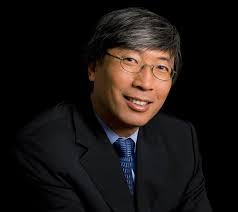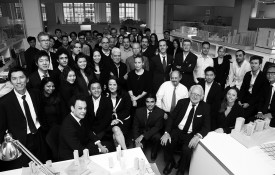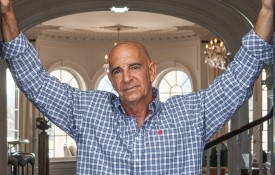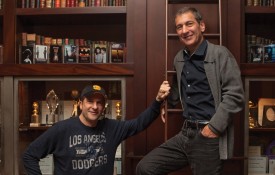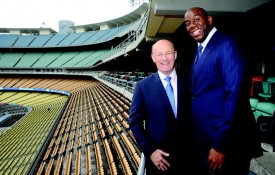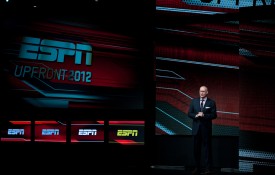Hearing Patrick Soon-Shiong describe his vision for the future of health care is nothing short of mesmerizing. In a measured tone as soothing as it is authoritative, he explains how he intends to centralize the various tentacles of the healthcare octopus – from physicians and research institutions to insurance and pharmaceutical companies – into one highly coordinated system operating in the cloud, providing individualized patient treatment based on real-time information. And while he’s orchestrating all that, he plans on obliterating cancer.
Understated charisma and easy smile notwithstanding, Soon-Shiong wins you over with sheer brainpower. He doesn’t ramble; he’s used to speaking extemporaneously with encyclopedic purpose, navigating double-helix roadmaps of complex jargon with surgical precision. Keeping up with his steady flow of concepts, you come away vastly impressed, and your belief in his ability to execute is bolstered by his impressive track record. “Cancer, if you think about it, is like a virus,” he says, making the concept seem elementary and graspable. “And if we can actually overcome that using your body’s own immune system, we can change the course of cancer.”
A native South African whose parents emigrated from China during WWII, Soon-Shiong met his future wife, Michele Chan, an actress in South Africa. They got married before moving to the U.S. and have made Los Angeles their home since 1980. Soon-Shiong studied at UCLA and joined the UCLA Medical School in 1983 as a transplant surgeon, performing the West Coast’s first successful pancreas transplant in 1987. “I came up through the world of immunology,” he recalls. “The unusual course was I also was doing pancreatic cancer surgery.” He eventually combined his expertise in transplantation, immunology, and cancer, training under Don Morton, who developed the first melanoma vaccine.
Soon-Shiong left UCLA in 1993 (he would return in 2009 to lead UCLA’s Wireless Health Institute) to form a diabetes and cancer biotech firm, and a few years later founded American Pharmaceutical Partners, which was acquired by Fresenius in 2008. Soon-Shiong also founded Abraxis BioScience, maker of his cancer drug, Abraxane, and sold that company to Celgene in 2010. Together, the deals netted Soon-Shiong more than $7.6B.
“So rather than explain it, there was an opportunity to just do it.”
CSQ visited with the 64-year-old doc-trepreneur at the Culver City headquarters of Nantworks, a cloistered campus filled with natural light, common spaces, high-tech equipment and some security precautions. Tucked into 30 acres, the nondescript exterior belies the concerted effort being expended in the name of Soon-Shiong’s celebrated Cancer Moonshot 2020, “to subdue cancer by the start of the next decade.”
Having just flown in from London the day before, Soon-Shiong was crisp and lucidly engaged. His dapper appearance, svelte frame, and salt-and-pepper hair that sweeps to the side as if parted by a light breeze all convey a vitality of someone decades younger. While the conversation touched on various aspects of his career and interests, the benevolent doctor, who calls himself “the CEO of the patient,” seems most comfortable when thoroughly diagnosing a problem and prescribing his remedy.
A Deeper Level of Understanding
There is not a person reading this who has not been touched in some way – either personally or through a friend or loved one – by cancer. There are more than 100 types that can affect humans. Excluding nonmelanoma skin cancers, the organs most susceptible to attack are the breast, lung, and prostate. Evidence of this vexing and enigmatic disease dates back thousands of years; the American Cancer Society estimates that more than 1.6 million new cancer cases will be diagnosed in 2016 and well over half a million people will die from cancer-related illnesses.
In spite of the sobering statistics, today there is a deeper understanding than ever of how the disease functions. Soon-Shiong believes we are poised to enter an age when cancer is identified as a manageable, chronic condition rather than a death sentence – a monumental shift in human history.
“The cancer cell is an amazing thing,” says Soon-Shiong. “I call it the greatest hijacker of all time. It can hijack every element inside your body and [use] the human biological system…to its own advantage to either cause itself to grow, cause itself not to die, or cause the immune system to be tricked and go to sleep,” he explains.
Harnessing genomics merely scratches the surface. Soon-Shiong recalls the knee-jerk euphoria when the human genome was sequenced in 2003. “Everybody celebrated and said, ‘We’re going to cure cancer.’ Actually, we realized you need to go down to the proteomics and the peptidomics and the immunomics and the metabolomics….” Soon-Shiong has shifted back into full scientific mode.
When posed with the question of whether it was even feasible to aggregate and analyze such a vast array of information down to the molecular level, a wide grin flashes across Soon-Shiong’s face. “We could, if we put our attention to it.” Not missing a beat, he adds, “Not only we could, we did.”
“The cancer cell is an amazing thing. I call it the greatest hijacker of all time. It can hijack every element inside your body and [use] the human biological system … to its own advantage.”
In 2005, Soon-Shiong forged ahead with the first phase of his plan to disrupt health care. He traveled to Bern, Switzerland, site of the Large Hadron Collider, to connect supercomputers around the world. Setting up operations on the National LambdaRail, where Higgs boson (the God particle) was identified, Soon-Shiong had an epiphany: What if he could harness this energy to create fiber a hundred times, even a thousand times, faster and identify God’s particle in every human being, every day, in real time? “If I said those words,” admits Soon-Shiong, “people would think I’m unrealistic. So rather than explain it, there was an opportunity to just do it. So I set about to build a fiber infrastructure linked to a supercomputing platform at a speed and scale that did not exist in the nation.”
Having built the fiber infrastructure, the next priority was artificial intelligence and developing a supercomputer capable of “almost unfathomable numbers of calculations in real time.” A machine vision team developed pattern recognition technology. In September 2011 Soon-Shiong launched NantWorks, the culmination of his sweeping vision to merge health care, commerce, technology, and digital entertainment, while developing new cancer therapies using semiconductors and supercomputing.
Today, NantWorks operates as the parent organization to a family of companies. NantHealth, which went public in June 2016 and is creating a software and medical records system for doctors, and hospitals), is the largest and most sweeping. Others include NantOmics (precision medicine), NantCell (immunology), and NantCloud (knowledge storage and transmission), as well as NantTronics, NantShield, NantMobile, NantBioScience, and NantStudio. In July 2015 the largest biotech IPO ever was made for NantKwest, a cancer drugmaker focused on the natural killer cell, found in the immune system.
“What you have at Nantworks,” Soon-Shiong exclaims, “is all the elements – mathematicians, molecular modelers, software engineers, cell biologists, immunologists, chemists, computer scientists, nurses, clinicians, clinical scientists, regulatory scientists – working together” in the name of QUantum, Integrative, Lifelong, Trial, or QUILT. The program aims to complete randomized clinical trials with cancer at all stages of the disease in up to 20 tumor types in as many as 20,000 patients by the year 2020.
In reaching this goal, Soon-Shiong feels strongly that access to real-time information will position local community oncologists as best-suited to administer treatment. “I think the idea that all wisdom lies within certain ivory towers and ask[ing] a patient dying of cancer to travel to different spots [around the world] is now obsolete.”
Origin of a Moonshot
In late 2014, Vice President Joe Biden’s son Beau Biden was battling brain cancer. Like any concerned parent, Biden was desperate to do whatever he could to help his son. So he sought out an expert. Soon-Shiong was not able to change the course of events and Biden’s son succumbed to the disease in May the following year. In that time, however, the Vice President and the groundbreaking billionaire surgeon bonded.
After Beau Biden’s funeral, the Vice President invited Soon-Shiong to the White House. At the time, Biden was mulling a run for the presidency. “He was deeply saddened by the loss of his son,” recalls Soon-Shiong. “I was happy to visit and be given the opportunity to console him during this difficult time.”

With a net worth of $11.9B as of August, 2016, Patrick Soon-Shiong is the richest resident of Los Angeles Photo: Albert Evangelista
“I [had written] a white paper called the Cancer Moonshot and I handed it to him. He had his advisers in the room and he said, ‘Oh my gosh, Patrick, if I do run, I’d run on the goal of finding a cure for this disease.’” The following week, Biden announced he would not be seeking the presidential nomination but if he were, his platform would center on curing cancer. In November 2015, Vice President Biden paid a quiet visit to the Culver City campus and was captivated by the infrastructure built to address the war on cancer.
In mid-January 2016, Soon-Shiong announced Cancer Moonshot 2020, starting the clock on a five-year mission to effectively reclassify cancer as a chronic disease rather than a potentially terminal illness. Two weeks later, during his final State of the Union address, President Obama announced that Biden would be leading the National Cancer Moonshot, a $1B initiative aimed at vaccine development, genomic analysis, and enhanced data sharing. (While the mission of the National Cancer Moonshot closely resembles that of Soon-Shiong’s endeavor, there is no formal connection between the two.)
An Enigmatic Figure?
There are two interests at play when considering matters that affect humanity on a grand scale: the capitalist brain, which seeks to capitalize on a specific opportunity, and the charitable brain, a selfless entity whose sole purpose is to direct resources into improving conditions or solving a specific problem. Soon-Shiong is Mensa-worthy on both sides. His brilliance as a researcher, surgeon, professor, and inventor is further amplified by his business savvy. Not only does he have the ability to see things in a way no one has before, he has reaped exponential profits from his endeavors.
According to Forbes’ Richest People in America list, Patrick Soon-Shiong’s net worth stood at $11.9B at the end of August 2016, making him the richest Angeleno and the 81st-richest person in the U.S. (Elon Musk, LA’s second-wealthiest person, came in at $10.7B.) Yet Soon-Shiong is highly attuned to the social responsibility that accompanies such profound success.
In 2010, he and his wife signed onto The Giving Pledge with fellow billionaires Bill and Melinda Gates and Warren Buffett, offering a moral commitment to give the majority of their fortune to philanthropy, either during their lifetime or upon their death.
Soon-Shiong clearly appreciates his wealth for the power it gives him – the power to affect positive change. “I find giving $100,000 to a researcher really makes very little impact,” he points out. “It may be very important science, but giving $100 million to a concerted effort where you can bring the best minds together and actually show outcomes in quasi-real time – that’s the model that we want to pursue.”
The Chan Soon-Shiong Foundation, which the couple founded in 2008, has embraced a mission of supporting funding research and improved access to health care and health education in the Los Angeles area.
“We really wanted to contribute not only our money, but also our intellect,” he says. “Unfortunately, tax law says you can’t do that from a private family foundation.” To satisfy this desire to actively participate in philanthropic policy, the Chan Soon-Shiong Institute of Molecular Medicine was established as a charitable support organization for healthcare systems.
Soon-Shiong squarely addresses critics who suggest that a doctor who stands to profit from a specific course of treatment may have a conflict of interest. After he developed Abraxane, which essentially uses the protein albumin to trick the cancer cell into feeding and is now approved for treatment of breast, lung, and pancreatic cancer, Soon-Shiong realized he might have a perception problem. “I was going to have a hard time [as] CEO of a company trying to sell this drug…when in fact I’m trying to get people to use less of the drug in a lower dose so that you could protect the immune system.” He sold Abraxis shortly thereafter but still holds the related patents. “My goal is to convince oncologists that pursuing maximum tolerated dose of chemotherapy is a misguided strategy. In fact, we should be using these drugs at a dose that would protect our immune system while perturbing the cancer cell and then finding ways to activate our body’s own immune protective system,” he explains. “This is the change in cancer care we will be pursuing for the next four years.”
LA Life (and Times)
An avid Lakers fan, Soon-Shiong has been a fixture at The Staples Center for decades. He could be spotted chatting with Kobe Bryant (a close friend) during warmups or rubbing shoulders with Denzel Washington or will.i.am at courtside. In 2010, Soon-Shiong purchased Earvin “Magic” Johnson’s stake in the Lakers, giving him a 4.5% ownership in his favorite team. Otherwise, Soon-Shiong is 95.5% pure fan, as evidenced by his animated demeanor when describing the Lakers’ chances for the 2016-17 season.
He is hoping the Lakers’ generation-spanning history of producing iconic game changers (i.e., Wilt, Kareem, Magic, Shaquille, Kobe) will yield fresh results. “I’m saddened by the fact that the Warriors have become the super team,” he acknowledges. But there is hope. “I think this new kid that we have [No. 2 draft pick Brandon Ingram] could be the next Kevin Durant,” he predicts. The Lakers represent an opportunity to promote positive engagement in the community. From the affluent to the downtrodden, courtside to nosebleed, purple and gold is the great equalizer. “When I worked with Kobe,” Soon-Shiong says, “one of his greatest strengths was to inspire young children.”
Basketball is a personal passion to the extent that Soon-Shiong has a full-size underground gymnasium at his Brentwood compound, which he illuminates with natural light via a delivery system that he co-invented. While he could easily summon an assortment of NBAers or Hollywood types to his private, state-of-the-art facility just by making a few calls, he favors UCLA’s Pauley Pavilion, where he drops in a couple times a week with Nantworks staff for pickup games.
“When I worked with Kobe, one of his greatest strengths was to inspire young children.”
Growing up in South Africa during apartheid, Soon-Shiong became sensitized to inequality and injustice at an early age. Los Angeles circa 2016 is a far cry from Soweto circa 1976, when race riots gripped the predominantly black section of Johannesburg. But Soon-Shiong sees the parallels and it can’t help but factor into his philanthropic activism.
“It was a travesty that a patient would actually be in the emergency room calling 9-1-1 and dying on the floor,” he says of King Drew Medical Center, which earned the nickname “Killer King” due to a number of similar occurrences. Equally appalling to Soon-Shiong is the fact that Los Angeles, the world’s melting pot, remains a chasm of demographic disparity that stretches from Beverly Hills to South Central LA.
A year after King / Drew was closed permanently due to repeated health and safety infractions, the Chan Soon-Shiong Foundation gave a $100M guaranty underwriting LA County’s proposal to reopen the facility as the Martin Luther King, Jr. Community Hospital.
“A newspaper, I think, is an opportunity to create glue amongst the community.”
“That’s why a lot of work my wife and I do [is] in South Central LA and everything I do with [Los Angeles County Board of Supervisors’] Mark Ridley-Thomas is reminiscent of the work that I grew up with. Nelson Mandela was still in prison when I was an intern in 1977. I was involved in treating the kids in the Soweto riots. So I understand very much the [concept] of oppressed people [and] trying to help the underdog.”
Speaking of helping the underdog, in May 2016 Soon-Shiong swooped in to administer life support to the Los Angeles Times. In an effort to ward off a buyout offer from Virginia-based media monolith Gannett Co., Inc., he invested $70.5M, making him No. 2 majority owner of the newspaper. The deal with Times parent company Tribune Publishing, which shortly thereafter rebranded itself tronc (short for Tribune online content), includes an agreement with NantWorks to license more than 100 technology patents and to produce video content at NantStudio.
“The LA Times is a national treasure,” he begins eulogistically. “The newspaper industry is clearly dying, and we need to move on. But the opportunity is to take this national treasure and use things like artificial intelligence, like what Pokémon Go is utilizing for example, and still allow the community to have something to which they can rally around. A newspaper, I think, is an opportunity to create glue amongst the community.”
Asked about mentors, Soon-Shiong says he admires those with a particularly solid body of work. “I’m a Burt Bacharach groupie, I truly am,” he reveals in earnest, before recalibrating his answer to reflect his professional influences. He mentions Dr. Donald Morton and Dr. Haile Debas, as well as an unnamed NASA physicist, since passed away, who spurred his curiosity in the area of artificial intelligence. Athletes inspire Soon-Shiong as well; he cites Kobe Bryant’s dedication to his craft and Pau Gasol’s compassion as examples.
In a downstairs conference room at Nantworks, there is a whiteboard with a drawing of a rocket ship surrounded by scrawlings and various calculations. Soon-Shiong created the diagram in 2009 when asked to further explain his proposed method for modernizing health care. “The top of that rocket ship is a thing called predictive modeling, whereby we are able to go through quantitative information of a patient’s proteome in real-time, identifying what we think is going to be best for the patient.”
Seven years later, having accomplished that goal, the whiteboard is a visual reminder that before great things can be executed, they must be envisioned. Now that the clock is ticking on Cancer Moonshot 2020, it’s crunch time and Soon-Shiong is in full fast-break mode. “Just watch us for the next four years,” he promises. “2020 is going to be a real deadline.”








































